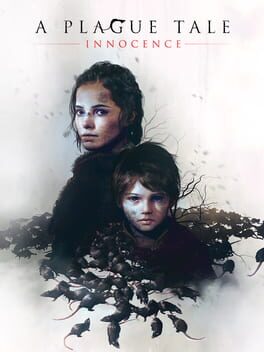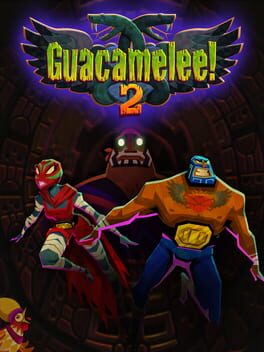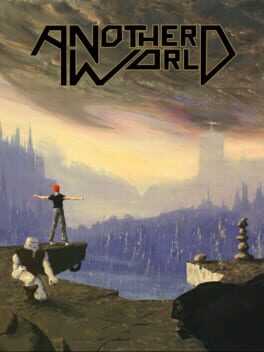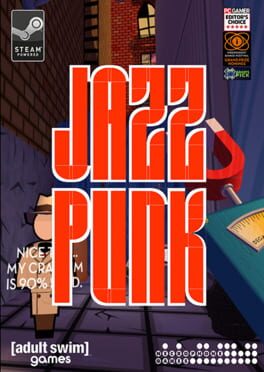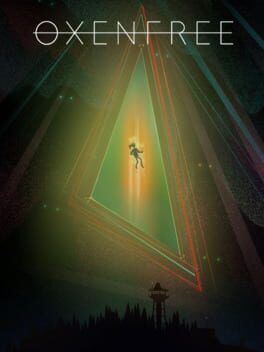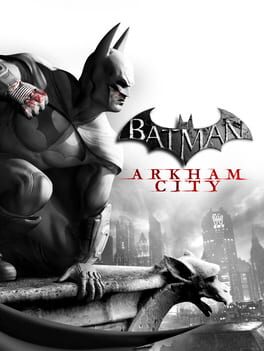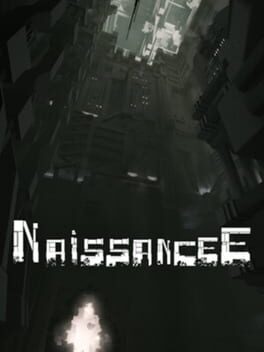jebhappy
2017
Arguably, the greatest horror works prefer to suggest rather than directly show. Little Nightmares can often be a mostly effective genre effort on the surface, for the way it suggests both creeping terrors and sly means of progression. Pianos dangle suspended by rope above miniature libraries; the sound of knives scraping against each other resounds from the kitchen a few rooms away; paltry childlike figures, similar to the protagonist, stand petrified within the sightline of an intimidating eye set in the wall of a prison.
These indications both instill an ambiguous dread within the miniscule player, as well as prime them to think quickly to outrun the danger. The game wastes no time with turorializing, prompting the inquisitive player to figure out the control scheme on their own, presenting an escalating array of maneuvers to enact through the early segment, simultaneously building atmosphere with macabre slow burn and preparing one's reflexes.
Quickly, however, the intrigue begins to lose steam. The immediate fail states often dissolve the tension during the game's most exciting moments, especially when the solutions to progress are sometimes a bit too unclear; and long loading times further plant a nail in the coffin. This points out a significant contradictory issue with most of these similarly cinematic, two-dimensional platformers starring children in oppressively bleak circumstances (post-Limbo sims, let's call them); an issue with a number of AAA prestige games, as well.
An attempt at offering both an accessible game and an experiential venture causes a swaying effect, not unlike the way in which the camera in Little Nightmares tilts back and forth like it were set aboard a massive ship at sea. Yes, the game creates a dreamscape out of dark shadows (and thus bright lights) and constant motion, not unlike a Lynch film, and preserves its location within the realm of the intangible.
But the traditional gameplay scenarios create a logic when there should be ceaseless surreality. The evocative monster designs and idiosyncratic spin on everyday settings sure look the part, but the menace is undermined by the rote gameplay scenarios, not strengthened. Perhaps worst of all, in its attempts at demonizing overconsumption, the creature designs inadvertently come off as fatphobic.
It's easy to fall for its occasional frightening tricks, like when long arms reach around corners like spider's legs at the player, or a chamber whelmed with shoes implies a long history of abuse. But most of the tension-building is centered around sneaking past unsuspecting mutant figures with little to no imagination in the actual doing (the kitchen sequence is a simple gauntlet based around avoiding eyesight; Ratatouille is more imaginatively intense).
Tarsier Studios' game looks the look but can't walk the walk -- save for a genuinely brilliant final act that subverts expectations with sparse, vacuous terror (the game is probably worth playing for this alone). In spite of its efforts, Little Nightmares just isn't nightmarish enough.
These indications both instill an ambiguous dread within the miniscule player, as well as prime them to think quickly to outrun the danger. The game wastes no time with turorializing, prompting the inquisitive player to figure out the control scheme on their own, presenting an escalating array of maneuvers to enact through the early segment, simultaneously building atmosphere with macabre slow burn and preparing one's reflexes.
Quickly, however, the intrigue begins to lose steam. The immediate fail states often dissolve the tension during the game's most exciting moments, especially when the solutions to progress are sometimes a bit too unclear; and long loading times further plant a nail in the coffin. This points out a significant contradictory issue with most of these similarly cinematic, two-dimensional platformers starring children in oppressively bleak circumstances (post-Limbo sims, let's call them); an issue with a number of AAA prestige games, as well.
An attempt at offering both an accessible game and an experiential venture causes a swaying effect, not unlike the way in which the camera in Little Nightmares tilts back and forth like it were set aboard a massive ship at sea. Yes, the game creates a dreamscape out of dark shadows (and thus bright lights) and constant motion, not unlike a Lynch film, and preserves its location within the realm of the intangible.
But the traditional gameplay scenarios create a logic when there should be ceaseless surreality. The evocative monster designs and idiosyncratic spin on everyday settings sure look the part, but the menace is undermined by the rote gameplay scenarios, not strengthened. Perhaps worst of all, in its attempts at demonizing overconsumption, the creature designs inadvertently come off as fatphobic.
It's easy to fall for its occasional frightening tricks, like when long arms reach around corners like spider's legs at the player, or a chamber whelmed with shoes implies a long history of abuse. But most of the tension-building is centered around sneaking past unsuspecting mutant figures with little to no imagination in the actual doing (the kitchen sequence is a simple gauntlet based around avoiding eyesight; Ratatouille is more imaginatively intense).
Tarsier Studios' game looks the look but can't walk the walk -- save for a genuinely brilliant final act that subverts expectations with sparse, vacuous terror (the game is probably worth playing for this alone). In spite of its efforts, Little Nightmares just isn't nightmarish enough.
Despite the fact that its robotic puzzle game mechanics fundamentally work at odds with the Lifelike world design and organic pacing (not to mention the ludicrous final act), A Plague Tale is so refreshingly humanistic I can't help but laud it as an overall effort. Amicia and the misfits she picks up along her journey to revive her sickened brother, are underdeveloped to a fault; writer, Sebastien Renard too often confuses building empathy for his characters with building sympathy. Also, it can be difficult to determine if the game is supposed to be a proponent of violence or critical towards it (Amicia's religious ethics are clouded by a developmental numbing to cruelty, confusing the game's principles).
But the moments that truly shine arrive whenever these children are faced with immediate danger, and are prompted to consider the chaos of the world outside the walls of their home, as they stare death in the face again and again. "Do we have to walk over them?" the boy, Hugo asks when the siblings are forced to venture across a battlefield littered with countless dead soldiers, a thick sheet of white obscuring the landscape like an ambiguous moral fog of war. "Does it hurt them?"
Few titles are as considerate of death as Asobo Studio's game, proposing existential rumination as an intrinsic process of growing up. The children's illustrious home and family are stripped away, sending them into mid-14th century wild France, where they meet a couple of penniless thieves constantly on the run, a young alchemist whose father is stricken by plague, and the burly, vengeful son of a blacksmith.
These characters are simple archetypes; however, by deconstructing typical fantasy RPG tropes, A Plague Tale examines the imaginative significance of the genre and the medium as a whole. Amicia acts like an heroic adventurer when the gang discover a ruined castle, flushing out the black, carnivorous, diseased rats to make a home out of the looming structure.
In many ways, the plot presents a progressive portrayal of rebirth, often linking alchemy to the role of a phoenix rising from ash. "Be brave, you can do this," each sibling will often say to their self when separated.
One ingenious sequence catalogues the villains' sinister operations as the player sneaks through an extensive gauntlet as wee Hugo, on a quest to free his captured mother. When he enters the chapel, it feels enormous and oppressive, but the game maligns not Christianity as a whole, but the corrupt men manipulating its moralistic practices. Faith is the foundation upon which civilization is erected. A plague has no motive, only heinous men do. The plague has taken lives and turned men into desperate monsters, but the meek shall inherit this ill earth.
But the moments that truly shine arrive whenever these children are faced with immediate danger, and are prompted to consider the chaos of the world outside the walls of their home, as they stare death in the face again and again. "Do we have to walk over them?" the boy, Hugo asks when the siblings are forced to venture across a battlefield littered with countless dead soldiers, a thick sheet of white obscuring the landscape like an ambiguous moral fog of war. "Does it hurt them?"
Few titles are as considerate of death as Asobo Studio's game, proposing existential rumination as an intrinsic process of growing up. The children's illustrious home and family are stripped away, sending them into mid-14th century wild France, where they meet a couple of penniless thieves constantly on the run, a young alchemist whose father is stricken by plague, and the burly, vengeful son of a blacksmith.
These characters are simple archetypes; however, by deconstructing typical fantasy RPG tropes, A Plague Tale examines the imaginative significance of the genre and the medium as a whole. Amicia acts like an heroic adventurer when the gang discover a ruined castle, flushing out the black, carnivorous, diseased rats to make a home out of the looming structure.
In many ways, the plot presents a progressive portrayal of rebirth, often linking alchemy to the role of a phoenix rising from ash. "Be brave, you can do this," each sibling will often say to their self when separated.
One ingenious sequence catalogues the villains' sinister operations as the player sneaks through an extensive gauntlet as wee Hugo, on a quest to free his captured mother. When he enters the chapel, it feels enormous and oppressive, but the game maligns not Christianity as a whole, but the corrupt men manipulating its moralistic practices. Faith is the foundation upon which civilization is erected. A plague has no motive, only heinous men do. The plague has taken lives and turned men into desperate monsters, but the meek shall inherit this ill earth.
2018
Guacamelee! 2 opens quietly. After a brief recap of the final events of its predecessor, we meet the settled luchador, Juan at home with his family, his physique stunted, silently glancing up at pictures of his old heroic self. His glory days seem behind him, but his rambunctious kids and caring wife offer a loving comfort; the game is immediately brazen in its depiction of the fabled 'happily-ever-after.'
Shortly after, the man is thrown back into another grand adventure to stop the universe from ripping apart at the seams. Guacamelee! 2 is basically creating a mirror effect with this clever introduction, reflecting back at 'gamer dads' and the like who look to games, and all media for a means of entertaining escape. The overall result is a stunningly-determined example of the power of videogames as a storytelling medium, with its unraveling plot sketched around the ludicrously well-designed levels and subtextually-inclined game design.
References to classic games abound, paying homage to the DrinkBox Studios developers' varying influences. Equal parts fighting game, 2D-puzzle platformer, brawler, and Metroidvania, the result is a one-of-a-kind and endlessly creative venture that deliberately recalls Street Fighter 2, Limbo, Bad Dudes, and others with joyful reverence.
But the game thankfully never takes itself too seriously, buoying every reference and conversation between NPCs with a goofy charm. Sure, the jokes feel a bit dated, but the light wit maintains the game's rhythm. And sure, its silly jab at live service games feels undermined by a DLC level being blocked off by a price tag. Nevertheless, the player is still getting more than enough bang for their standard buck; the game never stopped presenting new challenges and rewards throughout my 10+ hour playthrough, it is exquisite.
The unraveling difficulty is a marvel, as well as the intensely sophisticated level design. Metroidvanias often falter in their ambition since there are too many aspects to control, especially in regards to backtracking. Guacamelee! 2 is a feast for the eyes /and/ the mind, working forwards and backwards to form a fully-realised worldscape which reveals itself along a wonderfully-paced narrative arc. Chicken illuminatis, hellscapes frozen over, theatrical bosses, giant serpent heads, and talking shaman goats abound in a vacuum of imaginitive space. One really has to play it to believe it.
At its core, the game serves an ode to the videogame medium as an escapist dreamscape, where heroes thrive and silly villains tumble. Its multiple-universe plotting works in tandem with traditional platformer design, and creates a capsule where Life and death work in tandem -- a conceptual reality fundamentally literalized through thoughtful, vibrant design.
Most inspiring are moments where Guacamelee! 2 slows down to prompt self-reflection; hell, the villain even looks quite a bit like a bitter version of the protagonist. The Día de los muertos inspiration adds a somber energy to the calamitous situations, and through certain gameplay sequences, they provoke a blurring of the line separating the physical and the metaphysical.
The game does little that might be considered entirely "new," but its polish and ambition is often awe-inspiring. For as endlessly entertaining and properly challenging DrinkBox's game is, its cunning, humanistic facets elevate this Metroidvania above its like-minded contemporaries. Viva la old-school game design.
Shortly after, the man is thrown back into another grand adventure to stop the universe from ripping apart at the seams. Guacamelee! 2 is basically creating a mirror effect with this clever introduction, reflecting back at 'gamer dads' and the like who look to games, and all media for a means of entertaining escape. The overall result is a stunningly-determined example of the power of videogames as a storytelling medium, with its unraveling plot sketched around the ludicrously well-designed levels and subtextually-inclined game design.
References to classic games abound, paying homage to the DrinkBox Studios developers' varying influences. Equal parts fighting game, 2D-puzzle platformer, brawler, and Metroidvania, the result is a one-of-a-kind and endlessly creative venture that deliberately recalls Street Fighter 2, Limbo, Bad Dudes, and others with joyful reverence.
But the game thankfully never takes itself too seriously, buoying every reference and conversation between NPCs with a goofy charm. Sure, the jokes feel a bit dated, but the light wit maintains the game's rhythm. And sure, its silly jab at live service games feels undermined by a DLC level being blocked off by a price tag. Nevertheless, the player is still getting more than enough bang for their standard buck; the game never stopped presenting new challenges and rewards throughout my 10+ hour playthrough, it is exquisite.
The unraveling difficulty is a marvel, as well as the intensely sophisticated level design. Metroidvanias often falter in their ambition since there are too many aspects to control, especially in regards to backtracking. Guacamelee! 2 is a feast for the eyes /and/ the mind, working forwards and backwards to form a fully-realised worldscape which reveals itself along a wonderfully-paced narrative arc. Chicken illuminatis, hellscapes frozen over, theatrical bosses, giant serpent heads, and talking shaman goats abound in a vacuum of imaginitive space. One really has to play it to believe it.
At its core, the game serves an ode to the videogame medium as an escapist dreamscape, where heroes thrive and silly villains tumble. Its multiple-universe plotting works in tandem with traditional platformer design, and creates a capsule where Life and death work in tandem -- a conceptual reality fundamentally literalized through thoughtful, vibrant design.
Most inspiring are moments where Guacamelee! 2 slows down to prompt self-reflection; hell, the villain even looks quite a bit like a bitter version of the protagonist. The Día de los muertos inspiration adds a somber energy to the calamitous situations, and through certain gameplay sequences, they provoke a blurring of the line separating the physical and the metaphysical.
The game does little that might be considered entirely "new," but its polish and ambition is often awe-inspiring. For as endlessly entertaining and properly challenging DrinkBox's game is, its cunning, humanistic facets elevate this Metroidvania above its like-minded contemporaries. Viva la old-school game design.
2019
Hypnospace Outlaw is certainly an impressive feat, as the devs at Tendershoot have crafted a massive, sincere ecosystem of faceless, voiceless personalities to peruse through page by page in an endless quest for impossible digital connection. Ultimately, however, the game feels more like an exercise in tedium, literal work to be done for the sake of it (and I'm not even getting paid for it!).
The player is an enforcer, who brings down the 8-bit hammer of law in an attempt to maintain order throughout this developing online civilization -- indeed, Hypnospace Outlaw is practically a western, with its liminal setting and underlying sorrow; and they play the role of a cop. Tendershoot are unfortunately not smart enough to ponder the player's judicious role as all-powerful governor, nor as that of a meager cog in the system.
It's Papers, Please without the heart, and barely the 'game;' Her Story without the intrigue; meets Myspace, and with the uninspired wit of Pony Island. Is the game mocking or embracing the naivety of the internet in its youth? It's difficult to tell, for Hypnospace Outlaw proves a satire that seems unsure of where exactly to wag its critical finger.
The player is an enforcer, who brings down the 8-bit hammer of law in an attempt to maintain order throughout this developing online civilization -- indeed, Hypnospace Outlaw is practically a western, with its liminal setting and underlying sorrow; and they play the role of a cop. Tendershoot are unfortunately not smart enough to ponder the player's judicious role as all-powerful governor, nor as that of a meager cog in the system.
It's Papers, Please without the heart, and barely the 'game;' Her Story without the intrigue; meets Myspace, and with the uninspired wit of Pony Island. Is the game mocking or embracing the naivety of the internet in its youth? It's difficult to tell, for Hypnospace Outlaw proves a satire that seems unsure of where exactly to wag its critical finger.
1991
Another World is a cunning authorial work; one can assume that Lester, sitting at his sci-fi lab computer, preparing to plunge headfirst into another world, is a clear parallel to sole developer, Éric Chahi. That sly, carefree smirk on his face, brightened by the orange of his hair is all we need to understand the lack of consequence -- fitting, since the player is bound to die, over and over and over again.
A sort of precursor to the likes of Limbo (not to mention Oddworld and Uncharted and just about every 'cinematic'-esque title released in the past three decades), Another World seems almost determined to constantly kill the player at every interval, not maliciously but with a witty nudge-nudge as though Chahi were reveling in his cleverness. Often, games where the player can die inherently suggest a realisation of multiple universe theory; Another World plays out like a stitched-together account of Lester's numerous attempts across parallel worlds, fastened together by a self-aware charm that infers the protagonist himself acknowledges the inconsequentiality of death within this virtual realm. Limbo plays for shocks, but Chahi's cult classic plays for chuckles.
The game is always thinking two steps ahead of your next move; but it's always laughing with you, not at you. At its core, Another World presents a fundamental quest to get back home. Its ambiguous ending proves that, though such a goal isn't always attainable, a home can be wherever one finds comfort and friendship. The bulky confidant Lester meets along his journey is a voiceless outcast themself, and the two immediately empathize with each other without even having to speak.
Another World therefore presents a roadmap of the soul, complete with interchangeable waterways, daunting creatures, vast, arid, alien landscapes, and plenty of lasers. A mystifying environment, as much a threat as it is a vacation for our cool-headed Lester. Not to mention a vision of the future for games, a medium predicated on intense, elaborate escapism, where the limits to creative expression suddenly seem boundless.
A sort of precursor to the likes of Limbo (not to mention Oddworld and Uncharted and just about every 'cinematic'-esque title released in the past three decades), Another World seems almost determined to constantly kill the player at every interval, not maliciously but with a witty nudge-nudge as though Chahi were reveling in his cleverness. Often, games where the player can die inherently suggest a realisation of multiple universe theory; Another World plays out like a stitched-together account of Lester's numerous attempts across parallel worlds, fastened together by a self-aware charm that infers the protagonist himself acknowledges the inconsequentiality of death within this virtual realm. Limbo plays for shocks, but Chahi's cult classic plays for chuckles.
The game is always thinking two steps ahead of your next move; but it's always laughing with you, not at you. At its core, Another World presents a fundamental quest to get back home. Its ambiguous ending proves that, though such a goal isn't always attainable, a home can be wherever one finds comfort and friendship. The bulky confidant Lester meets along his journey is a voiceless outcast themself, and the two immediately empathize with each other without even having to speak.
Another World therefore presents a roadmap of the soul, complete with interchangeable waterways, daunting creatures, vast, arid, alien landscapes, and plenty of lasers. A mystifying environment, as much a threat as it is a vacation for our cool-headed Lester. Not to mention a vision of the future for games, a medium predicated on intense, elaborate escapism, where the limits to creative expression suddenly seem boundless.
2014
EUREKA!
Jazzpunk is a joyous, comedic ode to history: of games, of music, of film, of comedy, of civilization. Its sleuthy Cold War setting clashes with a cartoonish cyberpunk visage, which recalls Gravity Bone by way of the Marx Brothers. However, what could have been an exercise in political satire instead proves a masterpiece of subversive pop.
Whereas The Stanley Parable (a game similarly determined to think one step ahead of the player at every turn) proves a one-note, self-congratulatory farce, Jazzpunk is a walking sim which delights in the beauty of the mundane, exaggerating every trope and archetype it borrows from various media to create an endlessly delightful and unique vision. It is a game of juxtapositions; a genuinely artistic artifact which bridges the past and the future, music and movement, Lifelessness and stimulus. It's a game that strives to make the player laugh, whenever possible. A game where the player can't walk five feet without seeing another wild but clever gag. One's face is sure to hurt by the time the credits roll -- I wore a smile the whole way through.
Jazz and punk are two definitive American music genres, both at the forefront of their prospective eras; artists reconfigure the rules of songwriting in nearly antithetical ways. Jazz thrives on technical improvisation; punk strips a band down to its bare essentials and speaks in rudimentary rhymes. Jazzpunk, the game, proves sophisticated and joyously straightforward in its intentions, a true rarity within a medium gradually growing defined by technical and dramatic progress.
The basic spy caper plotting allows the developers at Necrophone Games to toss as many ideas into the pot as possible (notice the word 'pun' is right there in the title), filling each of the handful of maps with a bevy of content to peruse. The game is at its worst when relying on random, goofy dialogue interactions to pass the time; but at its best when spontaneous film references and inspired content transport the player through a simulated archive of historic video game influences. This is self-aware humor done right: not condescending, not bloated, but placed on an even playing field with the audience, in order to subsequently serve as a sort of commentary on the medium at large, whether intentional or not.
From "retiring" a group of "Realplicants," to aiding a gang of cyberpunk femmes in a bank robbery with a snot-gun; from entering the wrestling ring with a polygonal Randy Savage-clone, to entering cyberspace after being drugged and kidnapped by the self-proclaimed antagonists; Jazzpunk never stops surprising, all the way through to its reptilian, gastrointestinal finale, capping off a sequence in which the bad guy is thwarted by his own inflated ego (a fitting response to the Davey Wredens and Neil Druckmanns of the games industry). When times are tough, make 'em laugh.
Jazzpunk is a joyous, comedic ode to history: of games, of music, of film, of comedy, of civilization. Its sleuthy Cold War setting clashes with a cartoonish cyberpunk visage, which recalls Gravity Bone by way of the Marx Brothers. However, what could have been an exercise in political satire instead proves a masterpiece of subversive pop.
Whereas The Stanley Parable (a game similarly determined to think one step ahead of the player at every turn) proves a one-note, self-congratulatory farce, Jazzpunk is a walking sim which delights in the beauty of the mundane, exaggerating every trope and archetype it borrows from various media to create an endlessly delightful and unique vision. It is a game of juxtapositions; a genuinely artistic artifact which bridges the past and the future, music and movement, Lifelessness and stimulus. It's a game that strives to make the player laugh, whenever possible. A game where the player can't walk five feet without seeing another wild but clever gag. One's face is sure to hurt by the time the credits roll -- I wore a smile the whole way through.
Jazz and punk are two definitive American music genres, both at the forefront of their prospective eras; artists reconfigure the rules of songwriting in nearly antithetical ways. Jazz thrives on technical improvisation; punk strips a band down to its bare essentials and speaks in rudimentary rhymes. Jazzpunk, the game, proves sophisticated and joyously straightforward in its intentions, a true rarity within a medium gradually growing defined by technical and dramatic progress.
The basic spy caper plotting allows the developers at Necrophone Games to toss as many ideas into the pot as possible (notice the word 'pun' is right there in the title), filling each of the handful of maps with a bevy of content to peruse. The game is at its worst when relying on random, goofy dialogue interactions to pass the time; but at its best when spontaneous film references and inspired content transport the player through a simulated archive of historic video game influences. This is self-aware humor done right: not condescending, not bloated, but placed on an even playing field with the audience, in order to subsequently serve as a sort of commentary on the medium at large, whether intentional or not.
From "retiring" a group of "Realplicants," to aiding a gang of cyberpunk femmes in a bank robbery with a snot-gun; from entering the wrestling ring with a polygonal Randy Savage-clone, to entering cyberspace after being drugged and kidnapped by the self-proclaimed antagonists; Jazzpunk never stops surprising, all the way through to its reptilian, gastrointestinal finale, capping off a sequence in which the bad guy is thwarted by his own inflated ego (a fitting response to the Davey Wredens and Neil Druckmanns of the games industry). When times are tough, make 'em laugh.
2015
Out of the darkness and into the white. There is no more prolific nor consistently creative a horror game developer working right now than Puppet Combo (AKA Ben), and Power Drill Massacre remains his bloodcurdling masterpiece. The psycho killer romp is at once a glorious recreation of 80s-B-movie-style tales, wonderfully toeing the line between sex and violence; death enacting a vivid climax, severing the escalating tension with a blood-soaked hunting knife. The game forces its voluntary guinea pigs to lose themselves in the labyrinthine halls of its abandoned factory. The unstoppable killer is let loose to roam unpredictably, recalling the randomised antagonist of Slender, only with a far more gruesome appetite. Death after death, the mounting screams and impenetrable gates closing the player in dutifully offer up a most unadorned challenge: Survive. Polygonal terror for the post-VHS era, slathered in an unmistakably modern demeanor.
2016
EUREKA!
Not since Silent Hill 2 has grief been so thoughtfully illustrated within a game. In an era where cheap scares and lo-fi visuals plague the indie scene, Oxenfree excels at bridging the natural with the supernatural in the most sincere of storytelling methods. Character discussions flow with an organic pace, as heartbroken Alex meanders through the serpentine Edwards Island — a psychologically-rooted storybook limbo. The setting is the ideal representation of a woeful mind; denial syncs with time travel, voiceless longing is manifested within a crackling radio, a farewell embrace suggests the significance of companionship as a means of recovery. Oxenfree is a ghost story for the modern age, brimming with teenage wonder and remorseful connotation.
Not since Silent Hill 2 has grief been so thoughtfully illustrated within a game. In an era where cheap scares and lo-fi visuals plague the indie scene, Oxenfree excels at bridging the natural with the supernatural in the most sincere of storytelling methods. Character discussions flow with an organic pace, as heartbroken Alex meanders through the serpentine Edwards Island — a psychologically-rooted storybook limbo. The setting is the ideal representation of a woeful mind; denial syncs with time travel, voiceless longing is manifested within a crackling radio, a farewell embrace suggests the significance of companionship as a means of recovery. Oxenfree is a ghost story for the modern age, brimming with teenage wonder and remorseful connotation.
2016
EUREKA!
The illusion of control remains INSIDE’s most dedicated thematic irony. Video games often serve as a means of empowering the player, to escape a reality in which social structures define their every move. Playdead’s masterpiece profoundly constitutes the horrors of modern collective ignorance and hierarchical governance within the contexts of a side-scrolling puzzle game, most insidiously inferring that complete freedom means the surrender of Life itself. With each death, of which there are plenty, the player grows more and more weary of failure, serving as a reminder of the oppressive nature of the society from which they most certainly appear to be fleeing. The boy heaves and huffs as he so determinedly runs forward, down an ironically guided path, seeking some form of salvation. INSIDE’s most daring and cynical message seems to imply the impossibility of escape, a message that hauntingly reverberates throughout the entire game, right down to its gut-punching finale.
The illusion of control remains INSIDE’s most dedicated thematic irony. Video games often serve as a means of empowering the player, to escape a reality in which social structures define their every move. Playdead’s masterpiece profoundly constitutes the horrors of modern collective ignorance and hierarchical governance within the contexts of a side-scrolling puzzle game, most insidiously inferring that complete freedom means the surrender of Life itself. With each death, of which there are plenty, the player grows more and more weary of failure, serving as a reminder of the oppressive nature of the society from which they most certainly appear to be fleeing. The boy heaves and huffs as he so determinedly runs forward, down an ironically guided path, seeking some form of salvation. INSIDE’s most daring and cynical message seems to imply the impossibility of escape, a message that hauntingly reverberates throughout the entire game, right down to its gut-punching finale.
2013
EUREKA!
As much as this often frightening reboot feels constrained by its own series heritage, Tomb Raider lingers in the mind like a post traumatic encounter with death. Not just one death, but numerous visceral incidents where the body of the young Lara Croft is beaten, bruised, and expunged by the inhabitants (both living and ecological) of the aggressive island encasing her. Nearly every action taken -- scaling steep rockslides, forcing open doors and valves, investigating artifacts, skinning wildlife, hunting with bow and arrow -- emphasizes a burgeoning woman coming to grips with the menaces of culture as she explores and comes to recognize alarming truths.
A forested coming of age tale not unlike Gary Paulsen's Hatchet, sprinkled with the claustrophobic terrors of The Descent, and enveloped in Uncharted-inspired gameplay mechanics (with actual instated narrative accordance); Tomb Raider is overall a familiar product which often falls into typical AAA trappings. However, this wartorn experience investigates the fabrication of a brutal, apathetic soldier, a trepidatious tragedy made suitably empathetic by applying the lead's psychological journey through violent interactivity. In other words, Kill or be killed. "I can do this," Lara remarks early on, muttering affirmations to herself for the sake of survival, unaware of the monster she will later, inevitably become.
As the excessively gruesome scenarios unfold throughout the game, her determination to live eventually becomes an eagerness to conquer, as sickening as the incalculable death scenes prompted with every Game Over. A thrilling and dizzying ascent up an antenna tower to signal to civilization affirms the final process of her evolution: a huntress emerges bloodied and vindictive, callous towards those threatening her and fueled by an internal perseverance; she CAN do this. Supportive assurance becomes fact.
Indeed, every appalling casualty she suffers at the hands of the player's own failure wrecks the mind. Intentionally attempting to capture a debilitating and distressing audience reaction overall justifies the developers' brutal depictions, for it instills a similar determination within the player to push through hardships and ensure Lara's progress, no matter the human cost (her's or otherwise). A legitimate survival story as any other, flawed though it may be, thanks to forgettable archetypal characters and questionable scenarios; but nonetheless remarkably poignant and humanistic.
As much as this often frightening reboot feels constrained by its own series heritage, Tomb Raider lingers in the mind like a post traumatic encounter with death. Not just one death, but numerous visceral incidents where the body of the young Lara Croft is beaten, bruised, and expunged by the inhabitants (both living and ecological) of the aggressive island encasing her. Nearly every action taken -- scaling steep rockslides, forcing open doors and valves, investigating artifacts, skinning wildlife, hunting with bow and arrow -- emphasizes a burgeoning woman coming to grips with the menaces of culture as she explores and comes to recognize alarming truths.
A forested coming of age tale not unlike Gary Paulsen's Hatchet, sprinkled with the claustrophobic terrors of The Descent, and enveloped in Uncharted-inspired gameplay mechanics (with actual instated narrative accordance); Tomb Raider is overall a familiar product which often falls into typical AAA trappings. However, this wartorn experience investigates the fabrication of a brutal, apathetic soldier, a trepidatious tragedy made suitably empathetic by applying the lead's psychological journey through violent interactivity. In other words, Kill or be killed. "I can do this," Lara remarks early on, muttering affirmations to herself for the sake of survival, unaware of the monster she will later, inevitably become.
As the excessively gruesome scenarios unfold throughout the game, her determination to live eventually becomes an eagerness to conquer, as sickening as the incalculable death scenes prompted with every Game Over. A thrilling and dizzying ascent up an antenna tower to signal to civilization affirms the final process of her evolution: a huntress emerges bloodied and vindictive, callous towards those threatening her and fueled by an internal perseverance; she CAN do this. Supportive assurance becomes fact.
Indeed, every appalling casualty she suffers at the hands of the player's own failure wrecks the mind. Intentionally attempting to capture a debilitating and distressing audience reaction overall justifies the developers' brutal depictions, for it instills a similar determination within the player to push through hardships and ensure Lara's progress, no matter the human cost (her's or otherwise). A legitimate survival story as any other, flawed though it may be, thanks to forgettable archetypal characters and questionable scenarios; but nonetheless remarkably poignant and humanistic.
2015
Sylvio is a rare supernatural title which understands the significant connection between a place and the spirits which haunt it. A devilishly unique FPS, developer, Stroboskop’s paranormal investigation sim meshes amateur entrepreneurial work with ASMR-inspired terrors, transforming repetitive tasks into a sort of ritual for communicating with the rather restless dead. Scouring tapes — rewinding, playing them backwards, slowing down or speeding them up — is an enthralling and fittingly unnerving experience all on its own. However, perhaps what is most frightening is Sylvio’s assurance that these figments seem tied to the locations where they died, as though trapped by the circumstances of their deaths in an eternal fog of dissatisfaction. Death, as Sylvio appears to argue, is never as peaceful as we hope it to be.
2011
Arkham City itself is like a wonderful portrait brought to Life, a shadowy kingdom oozing corruption and crime. Neon lit billboards and vibrant building complexes draw the eye like grand focal points; the streets are littered with blackness and grime.
The citywide prison serves as a representation of impoverishment grown widespread, sequestered away from the upper class in a cold, menacing world to let its criminal inhabitants run loose. A playplace for hoodlums, a sort of purgatory intended to punish but instead starves, feeding off of their violent, capricious energy while they desperately fight for survival.
In the middle of it all stands the iconic Batman, caught between two ticking clocks counting down to certain doom, one involving the mysterious Dr. Strange's diabolical plot, the other his own confrontation with mortality, sickeningly devised by his arch nemesis, the Joker. It's a ridiculous and borderline asinine plot (not to mention its sexist portrayals of beloved female characters), which nonetheless oozes charm and hearkens back to old-school comic book escapism.
The in-game map is littered with objectives to complete, most of the side content considerably bold in their encapsulation of civic duty. Murder, disappearances, haunting figures, and yes, riddles; the dark knight is swamped with work to be done during this endless winter evening. Or rather, you, the player are swamped, with numerous responsibilities, all while under the constant threat of impending catastrophe.
Much talk of the entire Arkham franchise eventually devolves into applauding how each entry “makes you feel like Batman,” which is certainly true. But aside from the always-satisfying, balletic combat, with its ever-increasing challenge throughout the linear narrative, and the gadgetry, and Kevin Conroy's legendary performance, and the vast array of characters and references, hidden or otherwise; aside from these cleverly devised elements, it is the game's demanding strain of responsibility which most captures the impression of playing the Bat. And, alongside the genuinely wondrous artistic detail placed into every fabric of the world's gothic composition, it is through this dedicated design towards duty-driven storytelling which allows Arkham City to inspire awe at nearly every turn.
The citywide prison serves as a representation of impoverishment grown widespread, sequestered away from the upper class in a cold, menacing world to let its criminal inhabitants run loose. A playplace for hoodlums, a sort of purgatory intended to punish but instead starves, feeding off of their violent, capricious energy while they desperately fight for survival.
In the middle of it all stands the iconic Batman, caught between two ticking clocks counting down to certain doom, one involving the mysterious Dr. Strange's diabolical plot, the other his own confrontation with mortality, sickeningly devised by his arch nemesis, the Joker. It's a ridiculous and borderline asinine plot (not to mention its sexist portrayals of beloved female characters), which nonetheless oozes charm and hearkens back to old-school comic book escapism.
The in-game map is littered with objectives to complete, most of the side content considerably bold in their encapsulation of civic duty. Murder, disappearances, haunting figures, and yes, riddles; the dark knight is swamped with work to be done during this endless winter evening. Or rather, you, the player are swamped, with numerous responsibilities, all while under the constant threat of impending catastrophe.
Much talk of the entire Arkham franchise eventually devolves into applauding how each entry “makes you feel like Batman,” which is certainly true. But aside from the always-satisfying, balletic combat, with its ever-increasing challenge throughout the linear narrative, and the gadgetry, and Kevin Conroy's legendary performance, and the vast array of characters and references, hidden or otherwise; aside from these cleverly devised elements, it is the game's demanding strain of responsibility which most captures the impression of playing the Bat. And, alongside the genuinely wondrous artistic detail placed into every fabric of the world's gothic composition, it is through this dedicated design towards duty-driven storytelling which allows Arkham City to inspire awe at nearly every turn.
2017
EUREKA!
A masterpiece of minimalistic design principles, utilizing them as a catalyst for player character development, Cheap Golf revels in its wholly unique scenario. The game itself exists as a sort of imperceptible AI, though it is not a typical HAL/GLaDOS clone; instead of questioning subservience to human doctrine, this AI just wants to learn how to jive with the kids these days. Oh, and it wants you to call it SUSAN.
By reinterpreting standard golf mechanics into a two-dimensional artifice, the computer screen becomes a blank slate for SUSAN to develop its (her?) own intelligence; the player and the game share a symbiotic relationship in which the two feed off of each other’s evolving minds. Oftentimes, real links to websites will interrupt the monotonous trials to offer a glimpse into the future of human-machine communication. Ultimately the game serves as a reminder of the influence both that we have on technology, and technology has on mankind, portrayed through a familiar puzzle game conceit, which forges an often hysterical narrative of a quite lovable AI interface. Stare into the screen and find that the screen shall indeed stare back.
A masterpiece of minimalistic design principles, utilizing them as a catalyst for player character development, Cheap Golf revels in its wholly unique scenario. The game itself exists as a sort of imperceptible AI, though it is not a typical HAL/GLaDOS clone; instead of questioning subservience to human doctrine, this AI just wants to learn how to jive with the kids these days. Oh, and it wants you to call it SUSAN.
By reinterpreting standard golf mechanics into a two-dimensional artifice, the computer screen becomes a blank slate for SUSAN to develop its (her?) own intelligence; the player and the game share a symbiotic relationship in which the two feed off of each other’s evolving minds. Oftentimes, real links to websites will interrupt the monotonous trials to offer a glimpse into the future of human-machine communication. Ultimately the game serves as a reminder of the influence both that we have on technology, and technology has on mankind, portrayed through a familiar puzzle game conceit, which forges an often hysterical narrative of a quite lovable AI interface. Stare into the screen and find that the screen shall indeed stare back.
2014
"Lisa is lost. The first words etched across the screen, over a blank wall I wake up to after falling down a well. Something is chasing me. I am lost. The wall is saturated in white, grey, and black. It is a fitting image to introduce the deliberate composition of the game’s landscapes. A game? No, this is an excavation. An historical journey dripping with metaphysical anxieties. This lone human entity (or assumedly so) pants and heaves and must control her breath as she frantically treks through the serpentine catacombs. Rather, I must control it for her. We are lost.
Labyrinthine cityscapes forged out of the sides of chasms. Endless staircases and enormous vacant rooms. Statues of unfolding geometric shapes standing tall like monuments in a commemorative plaza. These iconic constructions beguile and amaze ceaselessly throughout the prodigious venture. Architecture is used to extract a freeflowing sense of wonder from the game’s audience, ebullient and surging as the journey itself."
You can read my thoughts on NaissanceE over at Project Icarus Gaming:
https://pig.gg/geometric-isolationism-and-morbid-anxiety-in-naissancee/
Labyrinthine cityscapes forged out of the sides of chasms. Endless staircases and enormous vacant rooms. Statues of unfolding geometric shapes standing tall like monuments in a commemorative plaza. These iconic constructions beguile and amaze ceaselessly throughout the prodigious venture. Architecture is used to extract a freeflowing sense of wonder from the game’s audience, ebullient and surging as the journey itself."
You can read my thoughts on NaissanceE over at Project Icarus Gaming:
https://pig.gg/geometric-isolationism-and-morbid-anxiety-in-naissancee/
2011
Portal 2 is not so much an exercise in worldbuilding as it is an exercise in establishing mood, a masterwork indulging in tonal variance. Mammoth sized test chambers confine our protagonist, Chell, within a dizzying gauntlet where her human intuition is ceaselessly tested by the ever-evolving AI, GLaDOS. The great shall outlive the small, and as evidenced by the game's winding, brilliantly-paced narrative, Humanity is entirely defined by the notion of achieving superiority. While the original Portal serves as a case study on the sinister after effects of seeking natural evolution through technological means; this thoroughly influential sequel operatically develops its predecessor's case, both dauntingly and hilariously, all while focusing on an inherent human deficiency regarding a desire to play God.
Most impressively, Valve have conjured a new brand of iconicism, painting every room, every corridor with the same brilliant and memorable aura as the last, kickstarting the decade's walking sim revolution. The developers necessarily convince their audience of Aperture's impossibly grand architecture, plus dish out plenty of material to finally outshine a certain fabrication involving cake. Forgive the lacking focus on puzzle design and gameplay situations, and get lost within the decaying passages where pursuing success sparks musical harmonies, and Life refuses to succumb to rot.
Portal 2 is an historical simulation, a sort of 'trip down memory lane.' Its methodical level design, in which the player eventually literally mingles amongst the buried past, proves that the more we push forward for the future of mankind, the more blinded and sickened by power we become. Strip away the convincing subtext, and what remains is a masterwork in fluidity, a makeup of genre-defying compositions, a transformative playspace with a slew of innovative experimental gel gimmicks, and one of the funniest games ever made, complete with voltaic potatoes, caroling turrets, combustible lemons, and the biggest moron ever built.
Most impressively, Valve have conjured a new brand of iconicism, painting every room, every corridor with the same brilliant and memorable aura as the last, kickstarting the decade's walking sim revolution. The developers necessarily convince their audience of Aperture's impossibly grand architecture, plus dish out plenty of material to finally outshine a certain fabrication involving cake. Forgive the lacking focus on puzzle design and gameplay situations, and get lost within the decaying passages where pursuing success sparks musical harmonies, and Life refuses to succumb to rot.
Portal 2 is an historical simulation, a sort of 'trip down memory lane.' Its methodical level design, in which the player eventually literally mingles amongst the buried past, proves that the more we push forward for the future of mankind, the more blinded and sickened by power we become. Strip away the convincing subtext, and what remains is a masterwork in fluidity, a makeup of genre-defying compositions, a transformative playspace with a slew of innovative experimental gel gimmicks, and one of the funniest games ever made, complete with voltaic potatoes, caroling turrets, combustible lemons, and the biggest moron ever built.

